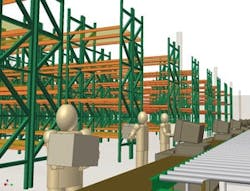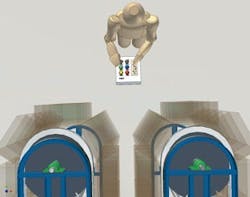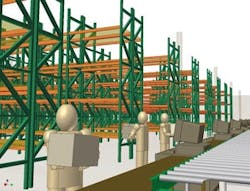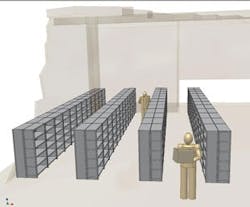Move inventory, not workers
Figure 1: Replacing static shelving with carousels results in a measurable increase in efficiency because stockers and pickers no longer have to use the same work area simultaneously. Injuries, bending and lifting are greatly reduced as products are now stocked and picked from a convenient working height. What was just storage space becomes space for product storage, order processing and transportation.
Storing discontinued partsFor example, a company regularly discontinues old parts and gives its distributors a specified time to return unsold merchandise. As the returned parts arrive, an operator keys the part number (or scans a bar code) into the system. The carousel sends the proper bin to the workstation for the operator to store the parts. Then the software updates inventory figures.When the grace period for returning this particular part ends, the system informs an operator, who empties the bin and sends the parts to inactive storage. The available bin now can be assigned another purposeprobably another discontinued part. Because software controls the system, similar parts don't need to be stored next to each other. Any available space can be used for anything that will fit, which eliminates the need for reorganizing the entire storage system periodically.VolumeA plant with three or more workers, each making more than 1,000 picks a day from inventory, might benefit from the productivity gains that horizontal carousels offer. The horizontal carousel can serve several stationary pickers simultaneously. Workers no longer have to walk from bin to bin in search of parts.While vertical carousels also offer productivity gains, it's usually not as a result of increasing volume. Vertical units usually serve individual workers who become more productive when they don't have to spend time picking when they should be doing something else.If acreage is at a premium, carousels can help. Horizontal systems may reduce space requirements to some extent just because of more efficient storage and a reduction in the number of workers needed to do the work, but the real savings come with vertical carousels. They use the top half of a facility that most plants underutilizewithout requiring extra space for forklifts or ladders to reach something stored on upper shelves. In this case, the carousel brings the parts down to the stationary picker standing on the floor.AccuracySoftware-driven carousels encourage accuracy. Even with simple keypad-controlled systems, workers are far less likely to make mistakes. In addition, items are less likely to be stored incorrectly, eliminating time wasted looking for lost items. In most material handling applications, accuracy is important not only because it contributes to productivity: it also can have an impact on customer satisfaction, return rates or subsequent stages in the manufacturing process.
Inventory controlWhen a plant installs a carousel system, it must revise storage procedures. This usually requires a thorough physical inventory and a rationalization of the process to produce a clean baseline for a fresh start with accurate information and better procedures. The carousel's accuracy makes it much easier to maintain the pristine condition.With software-controlled systems, the situation is even better. The computer specifies which picks to make and moves the proper bin to where it's a simple matter for an operator to make the picks accurately. Then it removes the picked items from the inventory record.ProductivityVertical carousels deliver the correct part or tool to a worker quickly and accurately. Horizontal carousels, like vertical types, allow for enormous productivity gains.Horizontal systems are usually installed in pods, with perhaps two carousels serving each operator. The now-stationary operator follows the instructions on the computer monitor and light trees on the carousel. Because the operator does nothing but pick, the number-of-picks rate rises dramatically.



